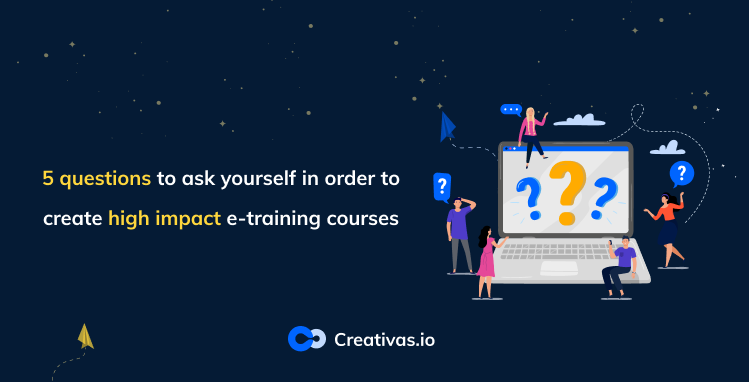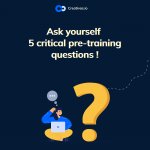
5 questions to ask yourself in order to create high impact e-training courses
Since many companies switched to virtual learning, AKA e-learning, it became mandatory to pay more attention to teams’ Training and Development (T&D). That’s why more effort has to be put into the quality of courses to impact the teams’ learning. Different strategies are put on the table, and it’s up to you to choose what best suits your team and your business goals.
The use of learning management systems made this easier than ever, but still carefully preparing for your courses is a must. You can’t just throw content to them. Wise planning for the e-training courses should be done by the concerned people in the organization. Generally, managers or leaders are the course creators because they know exactly what their teams need.
This blog hopes to serve 5 critical pre-training questions briefly to help course creators ensure high-impact e-training courses.
You need to ask yourself 5 questions before starting to create the course.
The “WHY?”
Why are you assigning this course to your team? Define the objective behind every course. Why are you having your team go through an e-learning session? It is essential to point out the goal of the training. You have to set a list of goals that your team needs to accomplish by the end of the year.
A big part of the “why” is about your team and their needs. To better understand them, you should look closely at their technical disparities, goals, motives, and the gap between where they are now, and where they should be.
When you fully understand your team, it will be easy to find courses’ ideas because it’s the needed skill that will benefit the organization that matters. Make sure your team comprehends the goal and the gain behind the course so that you achieve the course effectiveness needed. Try always to address courses related to the job to boost productivity within that position.
The “WHAT?”
What are they going to learn? It’s more about the content here. Focus on giving your team relevant information to their job positions. If you’re leading an IT team, you don’t have to teach them about customer relations or how to generate sales with a customer. Remember when we were in school, and we used to get annoyed by subjects that have no relevance to our studies. Like, am I ever going to use this?
It’s crucial to detect the correct content and make it relatable to the team as much as possible, like that you ensure a satisfied and acknowledged team and so a productive one.
The “WHEN?”
When are they taking the course? You have two options here. Either schedule a time for the course, or you can implement just-in-time e-learning like previously mentioned in our blog post. It’s your choice here, depending on your teams’ preferences & availability. You can try both and see which one impacts better on your team.
The “WHERE?”
Where are they attending the e-training course? You may get confused here by thinking we’re talking about the place. Since it’s virtual learning, so it’s home by default. But that’s not the answer to the question. We’re referring to the LMS tool.
We talked before about using an engaging LMS tool as it’s the most important part of e-learning. The tool should be compatible with all content types to make sure you insert visual and audio aids in addition to the text. The aim of the course is to leave a high impact on the learners, and this is unreachable if you’re not using the right LMS tool.
If you’re still deciding which tool to buy, you should probably look at our app Smart Courses for Confluence.
The “HOW?”
How should the content be? It should be impactful and compelling. The content is as important as the LMS tool. It would be best if you created something catchy that will teach the learners and entertain them.
The content should include quiz games, questions, or even fun videos or gifs to make it more engaging. Playing has always been fun for us since we’re little. We teach kids through playing, and this concept is still applicable till now and will always be. But not only kids can be taught through playing, adults as well. “Applying this concept has led to the term gamification that is used to describe an innovative approach using game mechanics in a non-gaming context (Deterding et al. 2011). It is an interdisciplinary approach seeking to motivate users to achieve certain behavioral or psychological outcomes (e.g., learn faster, complete their personal profile, daily use of a specific platform” (Stieglitz et al. 2017)
Researches showed that implementing gamification has a high impact on learners. “Recent psychological studies have shown that enhancing (with game elements) information systems resulted in a significant increase of software adoption in business environments, which in turn had a positive impact on the effectiveness and efficiency of employees.” (Herzig et al. 2012a, b)
We talked about Team Buiding content in a previous blog post, where we gave examples of engaging course activities. You can take those as examples, or you can create your own impactful training courses based on the session’s aim. Do not forget always to align your business goals with your training courses. Teams have to be constantly aware of what they’re working towards and what they should acknowledge by the end.
Briefly:








